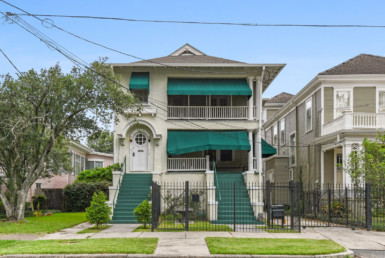Uptown

To the typical Uptowner, New Orleans was Uptown,” writes author Margaret LeCorgne. The Uptown National Register Historic District, beginning upriver of the Garden District and stretching to Broadway, is a self-contained residential world. It’s a place where late 19th century homes are scrupulously maintained and small scale restaurants and shops reinforce the feeling that you live in a village, not a city. Some of the best private and parochial schools in New Orleans make this neighborhood attractive to families. Because smaller shotgun and camelback houses are so abundant, especially close to the Mississippi River, Uptown draws renters and younger homeowners as well. Uptown was part of lands granted to Louisiana Governor Jean Baptiste LeMoyne, Sieur de Bienville in 1719, then divided into smaller plantations in 1723.
Sugar was first granulated on one of these, the de Boré Plantation, in 1794, and a major brickyard had developed on the Bouligny Plantation by 1820. Subdivision began when Faubourg Plaisance, now the area around Louisiana Avenue, was carved from the Wiltz Plantation next to Lafayette City in 1807. Upriver plantations followed suit by subdividing, a process encouraged in 1835 when the owners of Carrollton Plantation and several developers introduced the New Orleans and Carrollton Railroad. In 1850 seven faubourgs, or developments, combined to form Jefferson City (between Toledano and Joseph streets), which was then in Jefferson Parish.
New Orleans annexed Jefferson City and the settlements of Hurstville, Bloomingdale, Burtheville and Greenville, all of which are now part of Uptown, in 1870. By that time, prominent citizens had already begun building urban villas on entire squares along St. Charles Avenue. As land values rose, the squares were subdivided to permit more homes. It wasn’t until the 1884-85 World’s Industrial and Cotton Centennial Exposition on the present-day site of Audubon Park, however, that the areas away from St. Charles experienced a building boom. Today’s Uptown retains many of the grand homes built in the 1890s along St. Charles Avenue and in exclusive cul-de-sac developments like Rosa Park. On oak-shaded streets intersecting St. Charles, frame houses with ample galleries are the norm. Closer to the river, more modest shotguns built to house 19th century workers are steadily being refurbished, insuring that this premier urban residential neighborhood for over a century will continue its legacy of gracious living.
Courtesy of the Preservation Resource Center of New Orleans.











